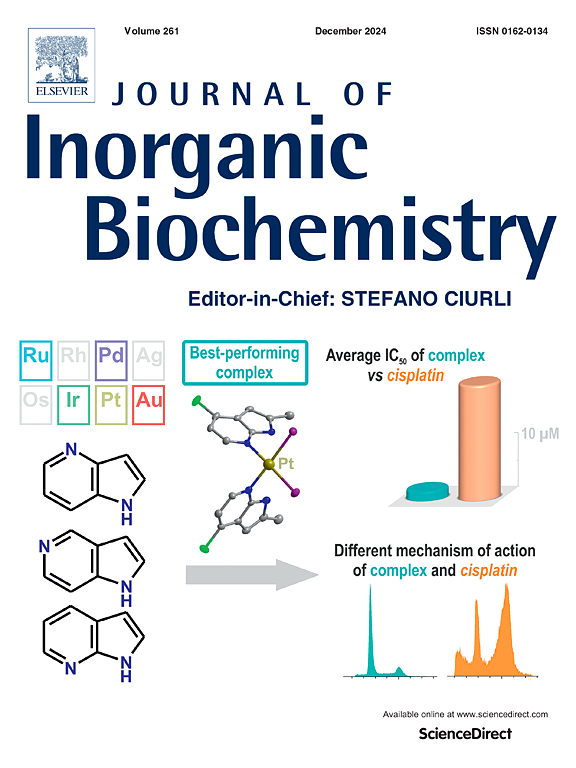Mössbauer对大肠杆菌中铁摄取调节剂[2Fe-2S]2+簇氧化还原状态的研究
IF 3.8
2区 化学
Q2 BIOCHEMISTRY & MOLECULAR BIOLOGY
引用次数: 0
摘要
用Mössbauer光谱法研究了在M9培养基中培养的大肠杆菌(MC4100)中过表达的流感嗜血杆菌和大肠杆菌的铁摄取调节蛋白(Fur)。先前的研究表明,来自流感嗜血杆菌和大肠杆菌的皮毛蛋白结合一个[2Fe-2S]2+簇,以响应细胞内游离铁含量的升高。本研究发现,当用二硫代盐还原纯化的Fur蛋白中的[2Fe-2S]2+簇时,被还原的簇被快速分解,形成具有高自旋Fe(II)的光谱特征的化合物,分别具有四面体和八面体配位。Fur中被还原的[2Fe-2S]1+簇的不稳定性是独一无二的,因为许多其他蛋白质中的[2Fe-2S] 2+簇可以可逆地进行单电子还原氧化。整个过表达Fur蛋白的大肠杆菌细胞的Mössbauer光谱显示出δ1 = 0.28 mm/s和ΔEQ1 = 0.52 mm/s的四极双峰,这是氧化[2Fe-2S]2+簇的典型特征,与纯化后的Fur蛋白相同。在大外加磁场下,相应的光谱显示出抗磁性模式,明确地揭示了一个具有抗磁性电子基态的交换耦合体系,这证实了它属于来自Fur的氧化[2Fe-2S]2+团簇。在大肠杆菌全细胞光谱中未观察到还原的[2Fe-2S]1+簇。不表达Fur的全细胞大肠杆菌的Mössbauer光谱不包含与Fur的[2Fe-2S]2+簇相关的成分。本文章由计算机程序翻译,如有差异,请以英文原文为准。
![Mössbauer studies of the redox state of the ferric uptake regulator [2Fe–2S]2+ cluster in Escherichia coli](https://img.booksci.cn/booksciimg/2025-4/102303254981777049469.jpg)
Mössbauer studies of the redox state of the ferric uptake regulator [2Fe–2S]2+ cluster in Escherichia coli
The Ferric uptake regulator (Fur) proteins from Haemophilus influenzae and Escherichia coli overexpressed in E. coli cells (MC4100) grown in M9 medium supplemented with 57Fe were studied with Mössbauer spectroscopy. Previous studies have shown that Fur proteins from H. influenzae and E. coli bind a [2Fe–2S]2+ cluster in response to elevation of intracellular free iron content. Here we find that when the [2Fe–2S]2+ clusters in purified Fur proteins are reduced with dithionite, the reduced clusters are quickly decomposed, forming compounds with two distinct spectral signatures of high spin Fe(II) in tetrahedral and octahedral coordination, respectively. The instability of the reduced [2Fe-2S]1+ cluster in Fur is unique, as the [2Fe–2S]2+ clusters in many other proteins can reversibly undergo one-electron reduction-oxidation. The Mössbauer spectra of whole E. coli cells overexpressing Fur proteins show a quadrupole doublet with the isomer shift of δ1 = 0.28 mm/s and ΔEQ1 = 0.52 mm/s, typical for oxidized [2Fe-2S]2+ clusters and identical with that in the purified Fur protein. The corresponding spectra in large applied magnetic fields show the diamagnetic pattern that unambiguously reveals an exchange-coupled system with a diamagnetic electronic ground state, which confirms its assignment to the oxidized [2Fe-2S]2+ cluster clusters from Fur. No reduced [2Fe-2S]1+ clusters of Fur are observed in the whole-cell E. coli spectra. The Mössbauer spectra of the whole-cell E. coli without the Fur expression do not contain the components associated with the [2Fe–2S]2+ cluster of Fur.
求助全文
通过发布文献求助,成功后即可免费获取论文全文。
去求助
来源期刊

Journal of Inorganic Biochemistry
生物-生化与分子生物学
CiteScore
7.00
自引率
10.30%
发文量
336
审稿时长
41 days
期刊介绍:
The Journal of Inorganic Biochemistry is an established international forum for research in all aspects of Biological Inorganic Chemistry. Original papers of a high scientific level are published in the form of Articles (full length papers), Short Communications, Focused Reviews and Bioinorganic Methods. Topics include: the chemistry, structure and function of metalloenzymes; the interaction of inorganic ions and molecules with proteins and nucleic acids; the synthesis and properties of coordination complexes of biological interest including both structural and functional model systems; the function of metal- containing systems in the regulation of gene expression; the role of metals in medicine; the application of spectroscopic methods to determine the structure of metallobiomolecules; the preparation and characterization of metal-based biomaterials; and related systems. The emphasis of the Journal is on the structure and mechanism of action of metallobiomolecules.
 求助内容:
求助内容: 应助结果提醒方式:
应助结果提醒方式:


